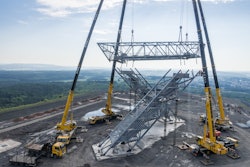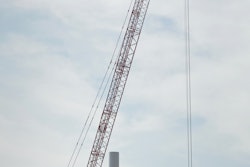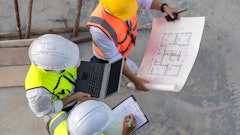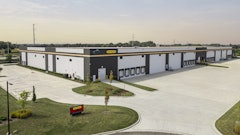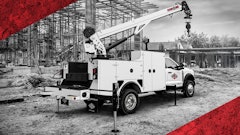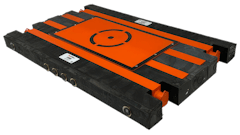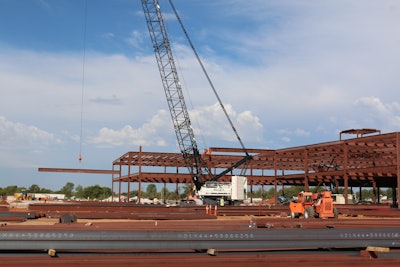
The challenge:
Steel erection for two-story structure including 1,300 picks within an eight-week pick plan with 120 picks including objects weighing 11,000 pounds or more
The players:
Big B Crane
Basden Steel Corporation
Deem Structural Services
The process:
Big B Crane and sister company Basden Steel Corporation, both of Burleson, TX, teamed up with Deem Structural Services of Longview, TX, to sell their services on schedule for a 290,000-square-foot, 2,100-ton building expansion project for a leading global aerospace company. Basden Steel provided fast-track design, assist and fabrication services for the contract, which began in May 2015 and closed just five months later. The full building project was expected to be completed in the summer of 2016.
The contract included an extremely tight steel and building slab erection schedule for the two-story structure. Big B Crane provided the lifting services for the eight-week pick plan. “We had to complete 1,300 picks within a very short time period,” explains Big B Crane President, Daniel Basden, “and 120 picks included objects weighing 11,000 pounds or greater.”
Ben McGregor, Vice President of Basden Steel’s Oklahoma division, adds, “We set a lofty goal of lifting 50 pieces a day to make the schedule.”
The original plan to complete the project was to use two, 150-ton capacity class cranes to lift the smaller pieces. When it came time to lift and position the heavy structural pieces, of which the heaviest weighed 12,500 pounds, then both cranes would be used in a tandem lift. This would have posed somewhat of a challenge for Big B Crane to stay on schedule, since Basden Steel and Deem Structural’s crews had such a short window to complete the erection work.
“You have to coordinate the swing radius when working with two cranes, so there is a lot of crane downtime,” explains McGregor. “If a single crane can be used, this reduces the time for many of the picks, and it increases lifting safety.”
This got Daniel Basden thinking about Big B Crane’s current fleet and the changing construction industry needs in the Texas and Oklahoma markets. “Concrete precast panels are getting bigger and heavier and steel is getting longer, so we were seeing a need for a higher capacity crawler crane than the two 250-ton class models we have in our fleet,” he says. Plus, those two cranes didn’t deliver the capacity needed on the building expansion project to eliminate the need for tandem lifts with the smaller cranes.
HC 285 crane just right
Daniel Basden searched for a higher capacity crane to eliminate the need to use the two 150-ton capacity cranes for the building expansion project. The original consideration was to jump to a 300-ton class crane, but this came with a sobering discovery. “The jump to the 300-ton capacity comes with a significant additional capital investment,” he says.
When Big B Crane representatives met with Terex Cranes distributor, Scott-Macon Equipment of Houston and Terex representatives, there was a lot of discussion about the lifting company’s capacity needs for its market. All parties then started to look at a new 285-ton capacity crane Terex recently introduced to the market. “The new HC 285 crane is a good in-between crane that gives customers virtually the capacity of a 300-ton class crane but at a price similar to that of a smaller crawler crane, so a company can receive a high return on investment,” comments Jim Strobush, Senior Product Manager — Crawler Cranes for Terex Cranes North America
Offering a maximum system length of 376 feet, the Terex HC 285 lattice boom crawler crane comes with a maximum 103.5-ton upper and 28-ton car body counterweight package to offer a 285-ton lift capacity at a 16-foot radius. While the crane’s lift chart rivals that of 300-ton cranes, its compact carrier can be transported in a single load.
“The base crane carrier measures less than 10.5 feet wide by 12 feet high, which enables it to be transported on a standard low-boy trailer, and the entire crane is designed with quick transportation in mind,” explains Strobush. Daniel Basden adds, “Many 300-ton crane carriers ship in two pieces, which adds one more load, another driver, additional set-up time and more expense.”
Since Big B Crane’s equipment is often used by Basden Steel on high profile projects like the building expansion, McGregor notices safety enhancements built into lifting equipment. “Safety requirements are high on our projects, and I see a lot of safety enhancements on the HC 285 crane,” he says. This includes a new tram fall protection system where the full length of boom is equipped with 20-inch-wide, heavy-duty, non-slip aluminum walkways and a track-guided travel tram that offers single-point harness hookup for full-length access to the boom during assembly and disassembly.
After analyzing all the capabilities and safety enhancements of the new Terex crawler crane, Big B Crane fast-tracked the crane order through Scott-Macon Equipment for the building expansion project. “Finishing the building expansion on schedule meant we needed that crane for the project,” says Daniel Basden. “Scott-Macon and Terex worked with us to get the crane to the jobsite when needed, and Scott-Macon’s service department has really taken care of our crane equipment needs over the years.”
The HC 285 crane was shipped directly from the Terex Oklahoma City facility, which just happened to be less than 10 miles from the project site. It was immediately assembled and put to work.
Ahead of Schedule
The lift plan for Basden Steel included positioning and slowly moving the HC 285 crane down the center of the building to lift the steel, joists, decking and staircases to the left and right of center for the new two-story structure. For the project, full upper and car body counterweight was used, and Big B Crane equipped the machine with the full 100-foot 16 HL jib and 180 feet of main boom.
“We averaged working at a 180-feet radius for the lifts,” says McGregor. Daniel Basden adds, “The HC 285 has a phenomenal lift chart. There is no way we could have finished this project as efficiently as we did without this crane being on site.”
McGregor mentions there weren’t any significant challenges when it came to the individual lifts. The major hurdle was sticking to the extremely short lifting schedule, so the frame construction phase could be finished on time. “We planned to lift 50 pieces a day, and we started lifting three days behind schedule,” he says. “Three weeks into the lifting phase, we were 164 pieces, or three days, ahead of schedule by using the HC 285 crane. We finished hanging our last piece of steel about one week ahead of schedule.”
In about seven weeks, the trio of Big B Crane, Basden Steel and Deem Structural lifted and placed 2,100 tons of steel with the aid of the Big B Crane’s new Terex HC 285 crane. “The crane gave us the combination of excellent reach and capacity, exactly what was needed for this project,” says Daniel Basden.
The week of October 19, Big B Crane’s crew began to disassemble the HC 285 crane to ship it to the company’s Burleson yard. “Move out was smooth and went as planned,” comments McGregor. “Having the HC 285 crane at the project saved us the time and expense for demobilization of a second crane. Everything on this project went according to plan. I wish all our projects could go this smoothly.”





